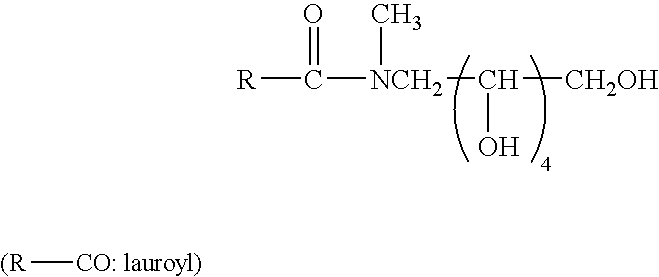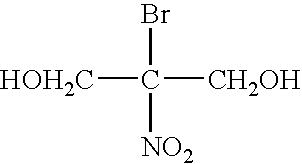Freshness-keeping agents for plants
- Summary
- Abstract
- Description
- Claims
- Application Information
AI Technical Summary
Benefits of technology
Problems solved by technology
Method used
Image
Examples
example 1
[0060]The freshness-keeping agents having the compositions shown in Table 1 were prepared (Inventive products 1 to 22 and Comparative products 1 to 11). In Table 1, the balance is tap water.
[0061]
TABLE 1Sugar derivative-based or sugaralcohol derivative-basedNo.Sugar (B)surfactant (A)Inventiveproduct 1Glucose 2.0%Decyl polyglucoside 100 ppm 2Sorbitol 0.1%Decyl polyglucoside 100 ppm 3Lactosucrose 5.0%Decyl polyglucoside 100 ppm 4Galactose 0.5% +Decyl polyglucoside 100 ppmglucose 0.5% 5Fructose 1.0% +Decyl polyglucoside 100 ppmglucose 1.0% 6Sucrose 0.5%Decyl polyglucoside 100 ppm 7Glucose 2.0%Sucrose fatty acid ester 100 ppm 8Sorbitol 0.1%Sucrose fatty acid ester 100 ppm 9Lactosucrose 5.0%Sucrose fatty acid ester 100 ppm10Galactose 0.5% +Sucrose fatty acid ester 100 ppmglucose 0.5%11Fructose 1.0% +Sucrose fatty acid ester 100 ppmglucose 1.0%12Sucrose 0.5%Sucrose fatty acid ester 100 ppm13Trehalose 1.0%Sucrose fatty acid ester 100 ppm14Glucose 2.0%Sorbitan fatty acid ester 100 ppm15Sorb...
example 2
[0071]The number of days for the rose being preserved was examined in the same manner as in Example 1 except that the concentrations of sucrose and sucrose fatty acid ester were varied as shown in Table 3 (the balance is tap water) and then the freshness-keeping agents were used. The numbers in Table 3 indicate the number of days for the rose being preserved. It can be seen that the number of days therefor being preserved is significantly improved when the content of the sucrose fatty acid ester is in the range of 0.0001 to 0.1% by weight and when the ratio of the sucrose fatty acid ester to / sucrose by weight is in the range of 0.00001 to 2.0. The sucrose fatty acid ester is the same as in Example 1. The number of days for the rose being preserved was 5 in all cases where commercial products Chrysal and Repeat, both diluted 50-fold, were used.
[0072]
TABLE 3ConcentrationConcentration of the sucrose fatty acidof the sucroseester (% by weight)(% by weight)00.00010.0010.010.10334430.1389...
example 3
[0073]Commercial Chinese cabbage and spinach having most similar growth conditions and freshness conditions within the possibility were selected. Each individual leaf was harvested therefrom one after another and examined in the test. Each of the leaves was immersed for 5 minutes at the room temperature in the freshness-keeping agents prepared in Example 1 (Inventive product 1 to 22 and Comparative products 1 to 8, 10 and 11 in Table 1). Thereafter, each of the leaves was removed therefrom, left at the room temperature for 48 hours and then measured for the weight of the leaf as an indication of the maintenance of freshness. The relative weight of the leaf to the weight (100) of the leaf just before immersion is shown in results of Table 4. It was shown from Table 4 that, as compared with Comparative products, Inventive products were confirmed to have the effect of keeping the freshness of the vegetables in all test systems and the freshness-keeping effect of the sugar (B) and the s...
PUM
 Login to View More
Login to View More Abstract
Description
Claims
Application Information
 Login to View More
Login to View More - R&D
- Intellectual Property
- Life Sciences
- Materials
- Tech Scout
- Unparalleled Data Quality
- Higher Quality Content
- 60% Fewer Hallucinations
Browse by: Latest US Patents, China's latest patents, Technical Efficacy Thesaurus, Application Domain, Technology Topic, Popular Technical Reports.
© 2025 PatSnap. All rights reserved.Legal|Privacy policy|Modern Slavery Act Transparency Statement|Sitemap|About US| Contact US: help@patsnap.com


